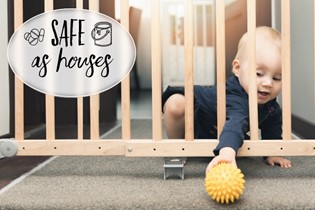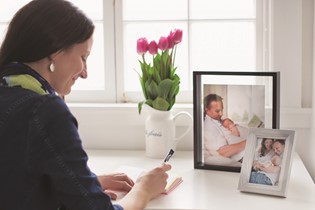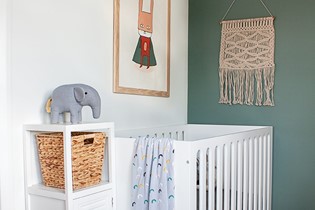When you can't work out, work in!

Renée Vincent helps new parents find ways to exercise in their own homes, and shares tips for designing a personalised and well-balanced workout.
Starting a family can be a time of great upheaval. All your previous routines and habits go out the window as you get to know your baby and get to grips with being on duty 24/7. One of the things parents often have trouble finding time for in their new routine is exercise. A 2014 BMC Public Health study looked at what got in the way of parents exercising, and found that the most common reasons parents gave for not exercising were feeling guilty for taking time away from family responsibilities, not having enough time, having to fit exercise around other commitments, and having to work. I hear mums voicing similar concerns at my clinic. While they really want to start getting fit again, they can’t work out a way to match exercise classes with their baby’s routine, or they can’t find child-friendly exercise classes. Sometimes they’re simply too tired to do a sustained period of structured exercise or are limited by weather, transport or other issues. Even if they have childcare, they feel bad taking time away from their baby.
However, exercise and physical activity are crucial for maintaining good health and help to keep you going as a parent, so you really need to find a way to get around these obstacles. The BMC Public Health study also looked at what made it easier for parents to exercise. One of the major facilitators was parents being able to fit physical activity in while they were with their children. They also found that parents who were motivated by being role models for their children were better at prioritising exercise for the family and carving out time to exercise. Being flexible about the time they exercised helped too, such as exercising when the baby was sleeping or before going to work, or before a partner left for work. Another factor that made a positive difference was if the parents had support – either through being able to exercise with others, or having support within their family.
GET BACK TO THE DRAWING BOARD
In order to make exercise happen, it can be helpful to teach yourself to get your physical activity or workout done at home and to fit it in around childcare activities. That way, if you are short on time or childcare, you don’t miss out on exercise. Some of you may have worked out at home successfully before and just need to figure out how to start again – with a post-pregnancy body and a baby in tow. But for those of you who have always done structured exercise (eg classes) and always outside the home, trying to exercise successfully at home might seem daunting. First you need to know what you're aiming for in terms of a successful exercise programme. Planning is key. Start by writing down your exercise plan, including possible times, childcare options, things that will motivate you and people who will support you. Think about the type of exercise you enjoy and note down any specific exercises, stretches or yoga moves that work well for your body. This will guide you as you choose your actual workouts. Brainstorm ideas for how you could break up your exercise through the day. For example, you could do mat exercises alongside baby during their tummy time. Figure out which of baby’s nap times might be good for exercising and the days your partner could have baby, so you can get out for a short walk, a bike ride or a run before doing the rest of your programme at home.
|
DESIGN A 'WORK IN' THAT IS... ⬜ At your current level. Be realistic and look for beginner or postnatal-specific workouts if you're just starting out. |
| ⬜ Safe. The last thing you need is an injury so listen to your body. Make sure you feel the exercise where it should be working; don’t push through pain. Choose workouts or exercises with clear instructions and clear pictures or videos explaining how to do them safely. |
| ⬜ Enjoyable. You’re much more likely to continue if you enjoy your exercise time, so if you manage to interact with your baby during it or choose a workout with great music or a supportive and inspiring instructor, you may find it easier to stick to it. Working out with another mum might help keep you going too. |
| ⬜ Rewarding. Your exercise plan should feel like it is making your body work in a way that makes you feel good. You should feel that you are noticing benefits in how you move, your posture, your strength or general wellbeing, or about how you feel in yourself. If not, then try something different. |
|
HERE'S ONE I PREPARED EARLIER |
|
RECONNECT WITH YOUR CORE To get you started, you can try the bird dog (see illustration below), a great foundational exercise for turning on your pelvic floor and deep abdominals. |
|
|
|
As well as the internet, your local library has a lot of exercise books on offer. If you have aches and pains or postnatal issues such as separated abdominals or pelvic floor problems, I would recommend seeing a physiotherapist for a personalised programme. Otherwise it’s time to grab a piece of paper, start brainstorming and create your home workout plan. |
TAKE YOUR PICK
The World Health Organisation recommends that in any given week you should do between 150 and 300 minutes of moderate exercise or 75 minutes of vigorous exercise. This means you need to schedule in at least 30 minutes a day to exercise. It doesn’t need to be done all at once, but at least 10 minutes at a time is recommended. Then you need to decide what kind of exercise you’ll do at home. These days we're truly spoilt for choice, thanks to the internet. You can easily research hundreds of types of exercise and have online access to thousands of workouts that you can do in your own home – many that include working out with your baby. You can sign up with a specific personal trainer and have a programme written for you, or find generic postnatal workouts, yoga, Pilates, high-intensity (HIT), boot camp, Zumba – to name only a few.

KEY COMPONENTS OR A 'WORK IN'
However, to choose the right programme you need to know what you want from the workout. For optimum health it is recommended that your fitness routine include cardiovascular exercise to get your heart rate up and increase your general fitness, resistance exercise for strength, core and pelvic floor exercises, and balance and flexibility training. You don’t need to fit all of these into one session but look to get at least two sessions of strength training a week and an element of stretching or flexibility after each session. You should also warm up and cool down.
During each session you should be working hard enough during the cardio to be able to hold a conversation, but not be able to sing. Cardio at home could be running on the spot, stationary bike, treadmill walking, skipping or dancing with your baby, for example. Or, if you prefer high-intensity interval training, you would alternate working hard enough that you can’t talk with periods of low-intensity exercise to recover your breath. During resistance training, you should aim to work most of the major muscle groups and to do 12–15 repetitions of each exercise, rest and then repeat this 3-4 times (ie 3-4 sets of 12-15). Examples of resistance exercise would be lifting weights (you can use dumbbells, barbells, or lift your baby), using bodyweight as resistance (eg doing push-ups or squats), or using resistance bands or tubing to work muscles. The flexibility component could be floor stretching or yoga poses, and you can work on balance using yoga or simple balance challenges (eg standing on one leg with your eyes closed).
| OHbaby! fitness expert Renée Vincent is a physiotherapist at Total Mums in Auckland and mum to an energetic young son. Find her at totalmums.co.nz. |

AS FEATURED IN ISSUE 43 OF OHbaby! MAGAZINE. CHECK OUT OTHER ARTICLES IN THIS ISSUE BELOW


















